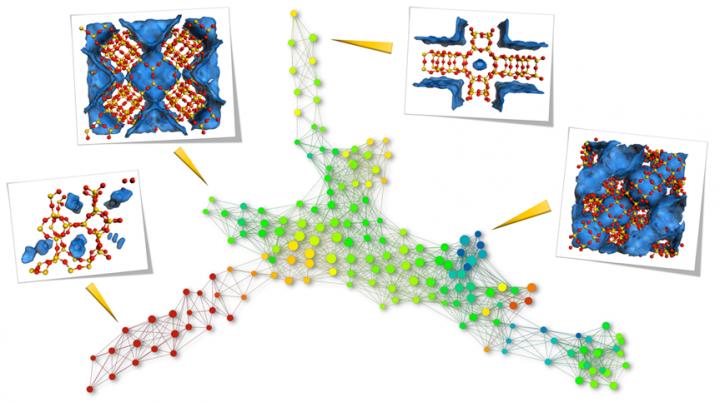A new tool for discovering nanoporous materials

Topological differences of top-performing materials for methane storage. Topological data analysis reveals the similarity between structures; each node represents a family of similar materials, while a network between two nodes indicates that they share at least one material. The further apart the nodes are, the more dissimilar the materials. The pictures show examples of nanoporous materials at the edges, and represent the topologically most different materials (red = Si, yellow = O, blue area = Pores) Credit: Berend Smit/EPFL
The search for nanoporous materials
Nanoporous materials comprise a broad category and can differ widely in their chemical makeup. What unites them is the presence of nano-sized pores in their three-dimensional structure, which endows them with catalytic and absorption properties. These pores can range between 0.2-1000 nanometers, and their size and shape (their “geometry”) can have a decisive effect on the material's properties. In fact, pore shape is as important a predictor of performance as chemical composition.
Today, computers can generate large databases of potential materials and determine — before having to synthesize them — which materials would perform best for a given application. But their chemistry is so versatile that the number of possible new materials is almost unlimited, while we do not have a method for quantifying and comparing similarity between pore geometries. All this means that finding the best nanoporous material for any given application is challenging.
Math to the rescue
A new method developed in a collaboration of the labs of Berend Smit and Kathryn Hess Bellwald at EPFL uses a technique from applied mathematics called “persistent homology”. This technique can quantify the geometric similarity of pore structures by adopting the mathematical tools that are commonly used by Facebook and others to find similar faces in uploaded photos.
The persistent homology method produces “fingerprints”, represented by barcodes, that characterize the pore shapes of each material in the database. These fingerprints are then compared to compute how similar the pore shapes of two materials are. This means that this approach can be used to screen databases and identify materials with similar pore structures.
The EPFL scientists show that the new method is effective at identifying materials with similar pore geometries. One class of nanoporous materials that would benefit from this innovation are the zeolites and the metal-organic frameworks (MOFs), whose applications range from gas separation and storage to catalysis.
The scientists used methane storage — an important aspect of renewable energy — as a case study. The new method showed that it is possible to find nanoporous materials that perform as well as known top-performing materials by searching databases for similar pore shapes.
Conversely, the study shows that the pore shapes of the top-performing materials can be sorted into topologically distinct classes, and that materials from each class require a different optimization strategy.
“We have a database of over 3,000,000 nanoporous materials, so finding similar structures through visual inspection is out of the question,” says Berend Smit. “In fact, going through the literature, we found that authors often don't realize when a new MOF has the same pore structure as another one. So we really need a computational method. However, while humans are intuitively good at recognizing shapes as the same or different, we needed to work with the math department at EPFL to develop a formalism that can teach this skill to a computer.”
“In the field of algebraic topology, mathematicians have formulated the theory of persistence homology in any dimension,” says Kathryn Hess. “Previous applications used only the first two of these dimensions, so it's exciting that chemical engineers at EPFL have discovered a significant application that requires the third dimension as well.”
###
This work was a collaboration between EPFL, INRIA (France) and UC Berkeley. It was funded by the US Department of Energy, the National Center of Competence in Research (NCCR) 'Materials' Revolution:Computational Design and Discovery of Novel Materials (MARVEL)' the Deutsche Forschungsgemeinschaft (DFG), the European Research Council (ERC; Horizon 2020; GUDHI).
Reference
Yongjin Lee, Senja D Barthel, Pawe? D?otko, S Mohamad Moosavi, Kathryn Hess, Berend Smit. Quantifying similarity of pore-geometry in nanoporous materials. Nature Communications 23 May 2017. DOI: 10.1038/ncomms15396
Media Contact
All latest news from the category: Materials Sciences
Materials management deals with the research, development, manufacturing and processing of raw and industrial materials. Key aspects here are biological and medical issues, which play an increasingly important role in this field.
innovations-report offers in-depth articles related to the development and application of materials and the structure and properties of new materials.
Newest articles

Silicon Carbide Innovation Alliance to drive industrial-scale semiconductor work
Known for its ability to withstand extreme environments and high voltages, silicon carbide (SiC) is a semiconducting material made up of silicon and carbon atoms arranged into crystals that is…

New SPECT/CT technique shows impressive biomarker identification
…offers increased access for prostate cancer patients. A novel SPECT/CT acquisition method can accurately detect radiopharmaceutical biodistribution in a convenient manner for prostate cancer patients, opening the door for more…

How 3D printers can give robots a soft touch
Soft skin coverings and touch sensors have emerged as a promising feature for robots that are both safer and more intuitive for human interaction, but they are expensive and difficult…





















